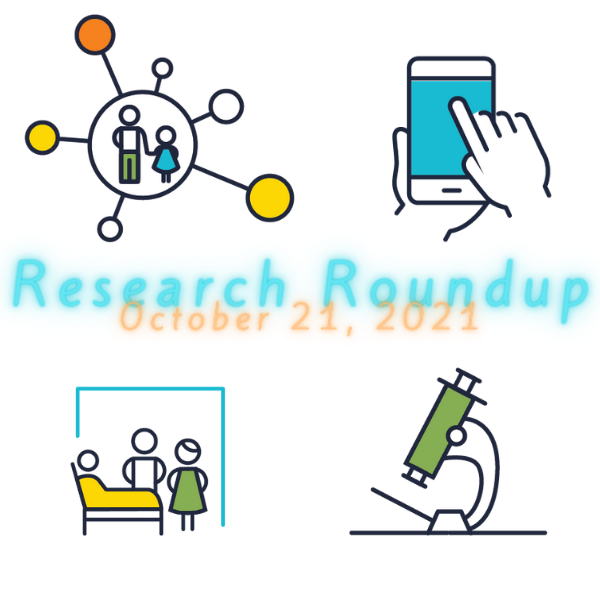Welcome to this month’s Research Roundup, a recurring overview of recent studies published by researchers at BC Children’s Hospital Research Institute (BCCHR) and the University of British Columbia, and their collaborators.

Even young infants can match unfamiliar voices with unfamiliar faces
BCCHR theme: Brain, Behaviour & Development
The ability to gain familiarity with someone’s voice is key to knowing who is speaking when there are no visual cues (such as in dark environments) and facilitates language development. But what learning mechanisms do babies use to learn the voices of unfamiliar speakers and match the voices to the speakers’ faces? And at what age do these learning mechanisms begin? Dr. Janet Werker and Dr. Adriel John Orena examined whether disambiguation (the expectation that novel voices match novel faces) and fast-mapping (the ability to quickly form and retain new face-voice mappings) are available in early infancy for the task of learning face-voice pairings. They found that both four- and eight-month-old infants looked more at unfamiliar faces when hearing unfamiliar voices, compared to when they heard their mother’s voice. This may indicate that the babies were purposely seeking an unfamiliar face to go with the unfamiliar voice. While previous studies have shown evidence for such learning mechanisms in preschool children, the researchers’ work indicates that even eight-month-old infants retain the face-voice pairings they’ve constructed. Additionally, their findings reveal that the use of disambiguation and retention in learning face-voice pairings occur far earlier (~4-8 months) than they do in word learning (~18-24 months for disambiguation and ~30 months for word retention).
“Our study provides new insights about early face-voice matching. The findings show that even young infants can use one-to-one mapping biases to track and learn the voices of those around them,” wrote Dr. Werker and Dr. Orena in “Infants’ Mapping of New Faces to New Voices.”
Read more in Child Development.
Proband status is a strong predictor of disease severity in pediatric catecholaminergic polymorphic ventricular tachycardia
BCCHR theme: Childhood Diseases
Catecholaminergic polymorphic ventricular tachycardia (CPVT) is a rare genetic condition that involves irregular heart rhythm brought on by physical activity or strong emotion. CPVT typically shows up in childhood or early adolescence as fainting or near fainting, but can lead to sudden death. Since a person with CPVT typically has a normal heart rhythm at rest and since fainting can be a sign of many other illnesses, CPVT can be difficult to diagnose. Despite therapeutic advances and the use of beta blockers, flecainide and other treatments, life-threatening cardiac events in pediatric CPVT remain high. Additionally, there is a lack of risk prediction tools to help healthcare professionals predict outcomes in pediatric CPVT patients. Dr. Shubhayan Sanatani, Dania Kallas, Dr. Thomas Roston, Dr. Sonia Franciosi, Laura Brett and their collaborators evaluated proband status (whether a patient is the first in their family to have CPVT), age of symptom onset and sex to see if these markers could serve as predictive factors to inform disease severity and/or therapeutic decision-making. Earlier literature has indicated that being the first in a family to have CPVT, being male or young age at symptom onset may indicate greater risk of sudden cardiac death.
Out of these three potential risk factors for greater CPVT disease severity, “only proband status independently predicted an earlier onset of life-threatening [cardiac] events during follow-up,” wrote Dr. Sanatani and his team in “Evaluation of Age at Symptom Onset, Proband Status, and Sex as Predictors of Disease Severity in Pediatric Catecholaminergic Polymorphic Ventricular Tachycardia.” The researchers note that additional research with larger sample sizes could enable investigation of other risk factors.
Read more in Heart Rhythm.
Virtual reality-based vs. standard procedural preparation for children getting MRI scans
BCCHR theme: Evidence to Innovation
Between 50-75 per cent of pediatric patients experience distress and anxiety before medical procedures such as medical imaging. If this distress and anxiety is not properly managed, some children may develop posttraumatic stress syndrome, phobias, changes in pain perception, experience poor coping or avoidance of medical care. At BC Children’s Hospital, over 4,500 pediatric patients undergo magnetic resonance imaging (MRI) every year and around 45 per cent require sedation. Waitlists for sedated MRIs are long and some patients have to wait longer than one year for their scheduled appointments. Alternatives to sedation are available and may include simulation and therapeutic play in some settings. John Jacob, Chelsea Stunden, Kirsten Stratton, and Sima Zakani developed a virtual reality (VR)-based intervention as an alternative to prepare children aged 4-13 for MRI. In comparing the VR intervention with two other alternatives currently used at BC Children’s, the team found that the VR intervention was comparable in preparing children for non-sedation MRI and alleviating both parents’ and children’s reported anxiety.
“Digital preparation apps using immersive media, such as our VR-MRI solution, could improve outcomes and patient experience by introducing standardized, accessible, and independently repeatable opportunities for experiential learning and preprocedural simulated practice. … The use of VR and the sequence of activities provided through the VR-MRI app show promise for preprocedural anxiety reduction in children and their caregivers,” wrote John Jacob and his team in “Comparing a Virtual Reality-Based Simulation App (VR-MRI) With a Standard Preparatory Manual and Child Life Program for Improving Success and Reducing Anxiety During Pediatric Medical Imaging: Randomized Clinical Trial.”
Read more in Journal of Medical Internet Research.
Genetic testing would reduce diagnostic delay in monogenic inborn errors of immunity
BCCHR theme: Healthy Starts
Inborn errors of immunity (IEIs) are a group of over 430 genetic disorders that result in a wide range of clinical manifestations such as increased susceptibility to infectious illness, autoinflammatory disease, allergy, and/or autoimmune conditions. Due to lack of awareness about IEIs among health care providers and due to the many ways IEIs can present, patients often experience long diagnostic delays that increase morbidity and mortality. Dr. Catherine Biggs, Dr. Bhavi Modi, Dr. Kyla Hildebrand, Dr. Scott Cameron, Dr. Anne Junker, Dr. Stuart Turvey and their collaborators conducted genetic testing on a cohort of 43 patients with monogenic IEIs, meaning that the IEIs resulted from a single gene mutation. These patients had a wide array of symptoms indicative of immune system dysfunction and experienced significant diagnostic delays of an average of 3.3 years. The team found that genetic testing provided the patients with a diagnosis, which positively impacted their treatment, follow-up and prognosis.
“Genetic sequencing has emerged as a key tool for early and accurate diagnosis of IEI patients but lacks funding support to expand access to testing. … This paper expands the paucity of literature on genetically confirmed IEIs in North America and supports the expansion of access to genetic testing for patients with clinical features suggesting IEI, such as those presented in our cohort,” wrote Dr. Biggs and her team in “Diverse Clinical Features and Diagnostic Delay in Monogenic Inborn Errors of Immunity: A Call for Access to Genetic Testing.”
Read more in Pediatric Allergy and Immunology.




